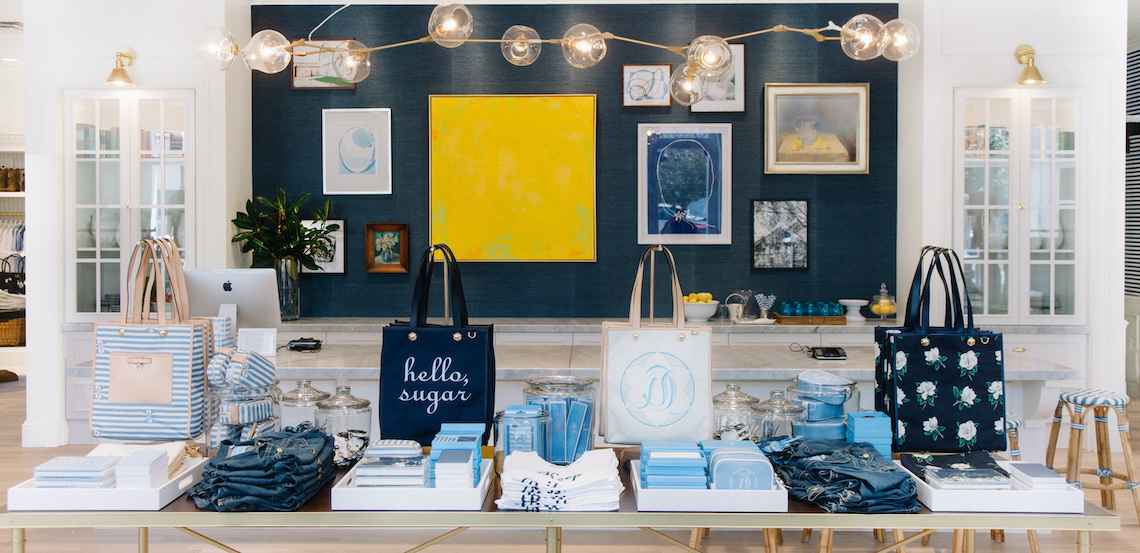Draper James CEO Erin Moennich has spent the last year forecasting the best way to continue the brand’s growth. Despite the rise in e-commerce across the apparel industry and Draper James’ own strength in online sales, she came to the conclusion that brick-and-mortar retail is what the brand needs.
In addition to its three existing stores in Nashville, Atlanta and Kentucky, Draper James opened two new stores in November. One is at the Houston Galleria in Houston, Texas, and the other is at the Mall of America in Bloomington, Minnesota. All of the brand’s other stores are street-level stores in markets where the brand already has a strong online presence. But the Mall of America location breaks from both of those traditions.
According to Moennich, the Mall of America store is part of the brand’s big retail experiment to see if it can use physical stores to drive the same customer acquisition that’s becoming increasingly expensive online. While the Houston store opened in Draper James’ largest market for online sales, the Mall of America store is meant to bring in new customers who haven’t heard of the brand before. Draper Janes is targeting locals and tourists alike.
“There’s definitely a rising cost in acquiring customers online, which has spiked even further since iOS14,” Moennich said. “We’re looking to retail as a place where we can recruit. We have some strategies in place, like a QR code at the point of sale to [prompt people to] sign up for SMS and get a discount for their order right there. That’s been working for us in our Nashville store, so we’re adding it to the new stores, too.”
Like other retail brands, Moennich said Draper James hasn’t necessarily found retail leases to be more affordable than they were pre-pandemic, especially when looking at some of the top-performing shopping centers in the country. But she did find that, with a large number of retailers closing stores permanently or moving them to other markets, top locations have openings they didn’t have before. Even at similar price points to pre-pandemic leases, more retail openings means more flexibility in finding the right fit.
“Simon [Property Group], which is the owner of the Houston Galleria, has been really busy, in terms of movement,” Moennich said. “There are a lot of brands that have taken the opportunity to move, which means there’s an opportunity for us to move in.”
Moennich said another one of the main appeals of brick-and-mortar is that Draper James can sell more full-price product. Of the brand’s direct sales, not counting wholesale, 80% are online and 20% are in-store.
Ad position: web_incontent_pos1
The two new stores are selling exclusive products, in the form of jewelry that can’t be bought online. They’re also hosting in-person events like book signings — for books in co-founder Reese Witherspoon’s popular book club — and events with local influencers.
The timing of the store openings was also intentional. Moennich said the team wanted to ensure the stores were open ahead of the holidays, in order to get an accurate read on how valuable they could be through the most crucial time of the year. At the beginning of 2022, she said she will evaluate the performance of the new stores and make decisions about how many new stores to open next year. Right now, the plan is to open 5-10 stores in the next two years. That amount and timeline may shift if the two new stores are a success.
Retail analysts have been saying for months that, even with the surge of online shopping, physical retail presences can still be important. That’s especially true for apparel. According to Michael Osborne, president of Wunderkind, some brands can get ahead of themselves, opening multiple expensive stores in expensive locations without fully knowing whether the return will justify the price. Instead, he said Draper James’ strategy of a slow test-and-learn approach is the ideal way to experiment with physical retail.
“Brands want to focus on online, but they want a physical visual presence to their brand, as well,” Osborne said. “Even though the investment is expensive, if you do it carefully and figure out what consumers want to buy in-person versus online, then it can make sense.”


